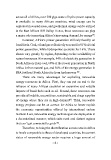Page 492 - 2016 - Vol. 40
P. 492
across all of Africa, over 300 giga watts of hydro power capacity
is available in many African countries, wind energy can be
exploited in coastal areas, and geothermal energy can be utilized
in the East African Rift Valley. Hence, these resources can play
a major role in meeting Africa’s increasing demand for energy(5).
However, Africa’s power generation still rely heavily on
fossil fuels. Coal, oil and gas collectively account for 81% of total
power generation, while hydropower accounts for 16%. These
shares vary greatly by region, depending on the availability of
natural resources. For example, 94% of electricity generation in
South Africa is from coal, 68% of the power generation in North
Africa is from natural gas, and 50% of the energy generation in
SSA (without South Africa) is from hydropower (6) .
There are many advantages for exploiting renewable
energy resources in Africa. First, they can put an end to the
reliance of many African countries on expensive and volatile
imports of fossil fuels such as oil. Second, these resources can
provide affordable, secure/clean, sustainable and cheap supplies
of energy where they are in high demand(7). Third, renewable
energy projects can be an avenue for Africa to better exploit
the economic opportunities offered by international carbon
markets. Last, renewable energy technologies are deployable in
a decentralized manner; which suits rural and distant regions
that can’t get connected to grids (8) .
Therefore, to bring the electrification access rates in Africa
to levels comparable to those of developed countries, the current
status of renewable energy sector requires a huge amount of
-4-

